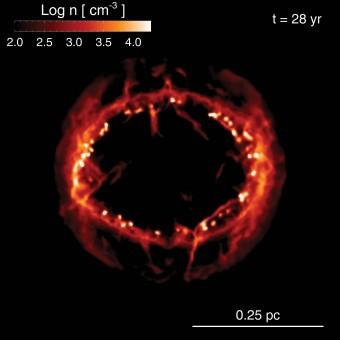Visualization of supernova explosions in a magnetised inhomogeneous ambient environment

Project reference: 2003
Supernova (SN) explosions are one of the most energetic phenomena in the universe. They represent the final fate of massive stars. SNe can briefly outshine entire galaxies and radiate more energy than our sun will in its entire lifetime. They’re also the primary source of heavy elements in the universe. Supernova remnants (SNRs), that are the outcome of SN explosions, are diffuse extended sources with a rather complex morphology and a highly non-uniform distribution of ejecta. The remnant morphology reflects, on one hand, the highly non-uniform distribution of ejecta due to pristine structures developed soon after the SN as well as the imprint of the early interaction of the SN blast with the magnetized inhomogeneous circumstellar medium.
In the framework of SoHPC program, as a first step, we aim to perform some SN explosion simulations by using the largely used PLUTO MHD code for astrophysical plasmas. PLUTO is one of the most popular Godunov-type MHD code developed in Europe and can be used to solve many astrophysical problems from relatively small scales (e.g. coronal loops formation) to galactic scales.
Clearly only the use of HPC resources can give us the possibility to simulate the evolution of complex systems like SNe and SNRs.
The second step of our project will be to analyse the data obtained from the SN-SNR simulations using the Interactive Data Language (IDL), or eventually python, and the tool Paraview for data visualization. Particularly, thanks to Paraview, we will produce some 3D models and movies of the SN explosion and subsequent full-fledged SNR. Finally, the 3D models will be also converted and uploaded on SKETCHFAB, one of the largest platform to share 3D models and virtual reality contents, to share student’s results inside the 3D creators community.

Copyright NASA

Copyright S. Orlando
You can find further materials on: https://sketchfab.com/sorlando/collections/universe-in-hands
Project Mentor: Salvatore Orlando
Project Co-mentor: /
Site Co-ordinator: Massimiliano Guarrasi
Participants: Seán McEntee, Cathal Maguire
Learning Outcomes:
At the end of the program the student will be able to:
- use the PLUTO code to perform an astrophysical simulation;
- use the Paraview software to extract 3D models from it;
- use Blender to prepare a movie;
- analyse scientific data using IDL or python.
He/she will increase also his/her skills on parallel programming models (especially MPI) and on scientific visualization.
Student Prerequisites (compulsory):
- C (first option) or Fortran (intermediate knowledge)
- Some concept about parallel computing and MPI (beginner)
- Python (intermediate knowledge)
Student Prerequisites (desirable):
- Paraview
- Blender
- IDL
- Numpy
- Matplotlib
- Astrophysics
- MHD modeling
Training Materials:
None.
Workplan:
- Week 1: Common Training session
- Week 2: Introduction to CINECA systems, PLUTO and Paraview.
- Week 3: Problem analysis, initial PLUTO setup preparation and deliver final Workplan at the end of week.
- Week 4, 5: Production phase (PLUTO simulations will be performed and results analysed with Paraview and IDL). (Depending on the results and timeframe, the number of simulations could be increased or decreased)
- Week 6, 7: Final stage of production phase. Preparation of the final movie. Creation of the model to be uploaded on sketchfab.com
- Week 8: Finishing the final movie. Write the final Report.
Final Product Description:
The final results of the project will be:
- A simplified model of SN-SNR will be prepared using PLUTO;
- Some vtk files containing the results of the simulations will be prepared;
- Some movies of the SN-SNR simulations will be published on the web;
A webpage on sketchfab.com containing the 3D models of SN-SNR.
Adapting the Project: Increasing the Difficulty:
If the time will be sufficient, we will increase the number and the complexity of the SN-SNR models.
Adapting the Project: Decreasing the Difficulty:
Depending the time we will have, we can reduce the number of models to 1 and omit the publication of the work on sketchfab.com
Resources:
The student will have access to our facility, our HPC systems, and all the Software and hardware required to complete the planned work.


Leave a Reply